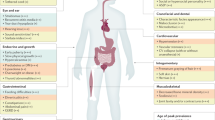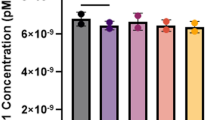Abstract
The degree to which genetic factors influence human intelligence remains a matter of some controversy. However, there is little doubt that single gene mutations can significantly alter brain development and function. For example, mutations affecting the FMR1 gene cause the fragile X syndrome, the most prevalent known inherited cause of intellectual dysfunction. The most common mutation occurring in the FMR1 locus involves expansion of a trinucleotide (CGG)n repeat sequence within the promoter region of the gene1. Between 6 and 54 repeats are typically observed in individuals from the general population2. When ≥200 CGG repeats are present, the expanded repeat sequence and an adjacent CpG island are usually hypermethylated, a phenomenon associated with transcriptional silencing of the gene and commonly referred to as the FMR1 full mutation3–5. The intermediate range of repeats (approximately 50 to 200 CGGs), referred to as the premutation, is characterized by the absence of hypermethylation within the promoter region and normal phenotype6,7. Some individuals have a combination of methylated and unmethylated alleles of differing size and are referred to as having mosaic status. Most males with the FMR1 full mutation function in the mentally retarded range of intelligence; in contrast, females with the FMR1 full mutation show a broader range of intelligence, from mental retardation to normal IQ8. The wider spectrum of cognitive functioning in females with the full mutation is likely to be due, in part, to variation in cellular X chromosome inactivation patterns and consequent FMR1 protein (FMRP) production in the brain. Despite differences in severity of intellectual dysfunction, both males and females with the FMR1 full mutation manifest a similar cognitive profile with weakness in the visual-spatial and attentional–organizational domains and relatively preserved verbal abilities9,10. Here, we show that the variance in child IQ predicted by mean parental IQ is decreased in 29 girls with the FMR1 full mutation compared to a non-fragile X group of 50 girls of similar age. We also show that activation status of the FMR1 gene, but not repeat size, is strongly correlated with intellectual function in girls with the full mutation, particularly for cognitive measures which distinguish fragile X from non-fragile X groups. These data indicate that FMR1 activation status is directly associated with the severity of intellectual dysfunction in girls with the fragile X syndrome.
This is a preview of subscription content, access via your institution
Access options
Subscribe to this journal
Receive 12 print issues and online access
$209.00 per year
only $17.42 per issue
Buy this article
- Purchase on Springer Link
- Instant access to full article PDF
Prices may be subject to local taxes which are calculated during checkout
Similar content being viewed by others
References
Verkerk, A.J. et al. Identification of a gene (FMR-1) containing a CGG repeat coincident with a breakpoint cluster region exhibiting length variation in fragile X syndrome. Cell 65, 905–914 (1991).
Fu, Y.H. et al. Variation of the CGG repeat at the fragile X site results in genetic instability: resolution of the Sherman paradox. Cell 67, 1047–1058 (1991).
Hansen, R.S., Gartler, S.M., Scott, C.R., Chen, S.H. & Laird, C.D. Methylation analysis of CGG sites in the CpG island of the human FMR1 gene. Hum. mol. Genet. 1, 571–578 (1992).
Pai, J.T. et al. Absence of FMR-1 gene expression can be detected with RNA extracted from dried blood specimens. Hum. Genet. 03, 488–493 (1994).
Pieretti, M. et al. Absence of expression of the FMR-1 gene in fragile X syndrome. Cell 66, 817–822 (1991).
Reiss, A.L., Freund, L., Abrams, M.T., Boehm, C. & Kazazian, H. Neurobehavioral effects of the fragile X premutation in adult women: a controlled study. Am. J. hum. Genet. 52, 884–894 (1993).
Rousseau, F. et al. A multicenter study on genotype-phenotype correlations in the fragile X syndrome, using direct diagnosis with probe StB12.3: the first 2,253 cases. Am. J. hum. Genet. 56, 225–237 (1994).
Hagerman, R.J. Physical and behavioral phenotype. in Fragile X Syndrome (eds. Hagerman, R J. & Cronister, A.C.) 3–68 (Johns Hopkins University Press, Baltimore, 1991).
Freund, L.S. & Reiss, A.L. A neurocognitive phenotype of young males and females with fragile X. Dev. Neuropsych. in the press.
Mazzocco, M.M., Pennington, B.F. & Hagerman, R.J. The neurocognitive phenotype of female carriers of fragile X: additional evidence for specificity. J. Dev. behav. Pediatr. 14, 328–335 (1993).
Plomin, R., DeFries, J.C. & McCleam, G.E. Behavioral Genetics: A Primer (W.H. Freeman and Company, New York, 1990).
Kemper, M.B., Hagerman, R.J., Ahmad, R.S. & Mariner, R. Cognitive profiles and the spectrum of clinical manifestations in heterozygous fra (X) females. Am. J. med. Genet. 23, 139–156 (1986).
Miezejeski, C.M. et al. A profile of cognitive deficit in females from fragile X families. Neuropsychologia 24, 405–409 (1986).
Loesch, D.Z. et al. Genotype-phenotype relationships in fragile X syndrome: a family study. Am. J. hum. Genet. 53, 1064–1073 (1993).
Rousseau, F. et al. Direct diagnosis by DNA analysis of the fragile X syndrome of mental retardation. N. Engl. J. Med. 325, 1673–1681 (1991).
Daniels, J.K. et al. IQ and variation in the number of fragile X CGG repeats: no association in a normal sample. Intelligence 19, 45–50 (1994).
Taylor, A.K. et al. Molecular predictors of cognitive involvement in female carriers of fragile X syndrome. JAMA 271, 507–514 (1994).
Abrams, M.T. et al. Molecular-neurobehavioral associations in females with the fragile X full mutation. Am. J. med. Genet. 51, 317–327 (1994).
Rochiccioli, P. et al. Study of final height in Turner's syndrome: ethnic and genetic influences. Acta. Paediatr. 83, 305–308 (1994).
Webb, T. & Jacobs, P.A. Fragile Xq27.3 in female heterozygotes for the Martin-Bell syndrome. J. med. Genet. 27, 627–631 (1990).
Tuckerman, E. & Webb, T. The inactivation of the fragile X chromosome in female carriers of the Martin Bell syndrome as studied by two different methods. Clin. Genet. 36, 25–30 (1989).
Rousseau, F., Heitz, D., Oberle, I. & Mandel, J.-L. Selection in blood cells from female carriers of the fragile X syndrome: inverse correlation between age and proportion of active X chromosomes carrying the full mutation. J. med. Genet. 28, 830–836 (1991).
McConkie-Rosell, A. et al. Evidence that methylation of the FMR-1 locus is responsible for variable phenotypic expression of the fragile X syndrome. Am. J. hum. Genet. 53, 800–809 (1993).
Wohrle, D., Hennig, I., Vogel, W. & Steinbach, P. Mitotic stability of fragile X mutations in differentiated cells indicates early post-conceptional trinucleotide repeat expansion. Nature Genet. 4, 140–142 (1993).
Taylor, A.K., Safanda, J.F., Lugenbeel, K.A., Nelson, D.L. & Hagerman, R.J. Molecular and phenotypic studies of fragile X males with variant methylation of the FMR1 gene reveal that the degree of methylation influences clinical severity. Am. J. hum. Genet. 55, A18 (1994).
Reiss, A., Abrams, M., Greenlaw, R., Freund, L. & Denckla, M. Neurodevelopmental effects of the FMR-1 full mutation in humans. Nature Med. 1, 159–167 (1995).
Wechsler, D. WISC-R Manual: Wechsler Intelligence Scale for Children-Revised. (The Psychological Corporation, New York, 1974).
Sattler, J.M. Assessment of Children (J. Sattler, San Diego, 1988).
Silverstein, A.B. Two- and four-subtest short forms of the Wechsler Adult Intelligence Scale-Revised. J. Consult clin. Psychol. 50, 415–418 (1982).
Author information
Authors and Affiliations
Rights and permissions
About this article
Cite this article
Reiss, A., Freund, L., Baumgardner, T. et al. Contribution of the FMR1 gene mutation to human intellectual dysfunction. Nat Genet 11, 331–334 (1995). https://doi.org/10.1038/ng1195-331
Received:
Accepted:
Issue Date:
DOI: https://doi.org/10.1038/ng1195-331
This article is cited by
-
The challenges of clinical trials in fragile X syndrome
Psychopharmacology (2014)
-
C9orf72 hypermethylation protects against repeat expansion-associated pathology in ALS/FTD
Acta Neuropathologica (2014)
-
High-functioning autism spectrum disorder and fragile X syndrome: report of two affected sisters
Molecular Autism (2012)
-
Fragile X-associated disorders: a clinical overview
Journal of Neurology (2012)
-
The neural basis of auditory temporal discrimination in girls with fragile X syndrome
Journal of Neurodevelopmental Disorders (2009)



